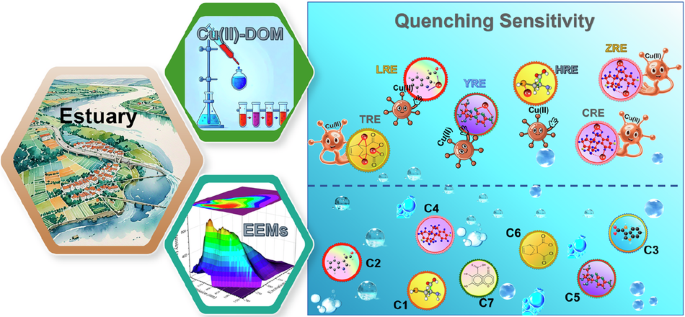Executive Summary
A comprehensive investigation into heavy metal pollution was conducted across six major estuaries in the north-west Pacific: Tumenjiang, Liaohe, Yellow River, Huaihe, Changjiang, and Zhujiang. The study focused on the environmental behavior and fate of copper(II) as it interacts with dissolved organic matter (DOM), a critical process influencing pollutant toxicity and mobility. This research directly addresses several Sustainable Development Goals (SDGs), particularly SDG 6 (Clean Water and Sanitation), SDG 14 (Life Below Water), and SDG 11 (Sustainable Cities and Communities). By employing advanced fluorescence and 2-dimensional correlation spectroscopy, the study identified distinct DOM components and their varying sensitivities to copper binding. Key findings indicate that industrial and anthropogenic pollutants, such as polycyclic aromatic hydrocarbon-like substances, exhibit strong sensitivity to copper binding in the highly industrialized Liaohe, Changjiang, and Zhujiang estuaries. This report highlights the urgent need for targeted pollution control strategies to mitigate ecological risks, protect aquatic ecosystems, and support the sustainable development of densely populated coastal regions, thereby contributing to the achievement of global sustainability targets.
Introduction: Estuarine Pollution and the Sustainable Development Goals
The Critical Role of Estuaries in Sustainable Development
Large-scale river estuaries serve as critical interfaces between terrestrial and marine environments and are home to approximately 60% of the global population. These ecosystems are vital for biodiversity, economic activity, and human well-being. However, their role as natural receptacles for land-based runoff makes them highly susceptible to contamination. The accumulation of pollutants in these zones directly threatens the achievement of several SDGs.
- SDG 14 (Life Below Water): Estuaries are foundational to marine biodiversity. Pollution from land-based activities directly undermines Target 14.1, which aims to prevent and significantly reduce marine pollution of all kinds.
- SDG 11 (Sustainable Cities and Communities): The health of estuaries is intrinsically linked to the sustainability of the major cities situated along them. Managing pollution is essential for fulfilling Target 11.6, which seeks to reduce the adverse per capita environmental impact of cities.
- SDG 6 (Clean Water and Sanitation): Estuarine water quality is an indicator of the health of entire river basins. Addressing pollution in these areas is crucial for Target 6.3, which focuses on improving ambient water quality by reducing pollution.
Heavy Metal Contamination as a Barrier to SDG Achievement
Heavy metals, particularly copper (Cu), represent a significant threat due to their toxicity, persistence, and capacity for bio-accumulation within the food chain. Industrial applications and anthropogenic activities in the catchments of the Tumenjiang, Liaohe, Yellow, Huaihe, Changjiang, and Zhujiang rivers have led to latent heavy metal pollution. Understanding the interaction between copper and DOM is essential for predicting its environmental fate and developing effective mitigation strategies. This study aims to elucidate these complex binding properties to provide a scientific basis for environmental risk assessment and management, thereby supporting progress toward a sustainable and pollution-free aquatic environment as envisioned by the SDGs.
Analytical Framework and Methodology
Study Area and Sampling
Water samples were collected throughout 2023 from six major estuaries in China, spanning a wide latitudinal range in the north-west Pacific. These locations were selected due to their ecological significance and the intense anthropogenic pressures they face, which pose challenges to achieving SDG 11 and SDG 14. Water quality parameters, including temperature, pH, dissolved oxygen (DO), and various chemical indicators (COD, BOD, nitrogen, phosphorus), were measured to provide a comprehensive environmental context.
Spectroscopic Analysis of Copper-DOM Interactions
To investigate the mechanisms of pollution, a series of titration experiments were conducted. The binding behavior of copper(II) with DOM was analyzed using advanced spectroscopic techniques. This approach provides critical data for managing water quality in line with SDG 6.
- Fluorescence Excitation-Emission Matrix Spectroscopy (EEMs): Used to detect the fluorescence characteristics of DOM in the water samples.
- Parallel Factor Analysis (PARAFAC): A chemometric model applied to EEMs data to identify and quantify the distinct fluorescent components of DOM.
- 2-Dimensional Correlation Spectroscopy (2D-COS): Employed to determine the sequential order and sensitivity of DOM components binding with copper(II), revealing which pollutants are most reactive.
Chemometric and Statistical Modeling
Data were further analyzed using a modified Stern-Volmer model to calculate the binding capacity and stability constants of copper-DOM complexes. A Structural Equation Model (SEM) was developed to reveal the causal relationships between water quality parameters, DOM fractions, and copper-binding mechanisms. This integrated analytical approach provides a robust framework for understanding pollution dynamics and informing sustainable management practices.
Key Findings on Copper Pollution Dynamics
Characterization of Dissolved Organic Matter (DOM) Components
Seven distinct fluorescent components were identified across the six estuaries. The composition of DOM varied, reflecting different sources of organic matter and pollution, which is critical for tracing pollution back to its source as part of achieving SDG 12 (Responsible Consumption and Production).
- Common Components: Free amino acid-like, tryptophan-like, microbial-derived humic-like, and fulvic-like substances were present in nearly all estuaries, indicating widespread biological and natural organic inputs.
- Pollution Indicators: Polycyclic aromatic hydrocarbon-like (PAHLF) substances, associated with industrial pollution, were found in all estuaries except Tumenjiang River Estuary. This points to a lower industrial impact in the TRE region.
- Unique Components: Terrestrial-derived humic-like substances were found only in the Tumenjiang River Estuary, while D’tryptophan-like substances were unique to the Yellow River Estuary, suggesting distinct local environmental conditions.
Copper-Binding Behavior and Sensitivity across Estuaries
The study revealed that different DOM components have varying sensitivities to copper binding, which dictates the mobility and bioavailability of this toxic metal. These findings are crucial for prioritizing efforts to protect aquatic life (SDG 14).
- Liaohe, Changjiang, and Zhujiang Estuaries: In these highly industrialized regions, PAHLF exhibited a strong sensitivity to copper binding, confirming that industrial pollutants are key players in heavy metal dynamics. This highlights a direct challenge for SDG 11 and SDG 12.
- Tumenjiang River Estuary: Humic-like substances showed the strongest sensitivity, reflecting a greater influence from natural, terrestrial sources.
- Yellow River Estuary: Microbial-derived humic-like components were the most sensitive, indicating the importance of microbial processes in this ecosystem.
- Huaihe River Estuary: Free amino acid-like substances were most sensitive, suggesting a significant influence from recent biological or sewage-related inputs.
Influence of Environmental Factors on Pollution Mechanisms
The binding of copper with DOM was influenced by various water quality parameters. Chemical pollutants (COD, BOD, TP) were found to promote the continuity of copper binding with most DOM fractions, exacerbating the persistence of metal pollution. Conversely, physical parameters like dissolved oxygen and temperature were found to reduce these binding continuities. This interplay underscores the complexity of managing water quality to meet the targets of SDG 6.
Implications for Sustainable Development Goal (SDG) Attainment
Advancing SDG 6 (Clean Water) and SDG 14 (Life Below Water)
This research provides a detailed understanding of the behavior of copper, a priority pollutant, in major aquatic ecosystems. By identifying the specific organic matter fractions that bind most strongly with copper, this work enables the development of more targeted and effective water treatment and pollution control strategies. The findings directly support:
- Target 6.3: By improving the scientific understanding needed to reduce water pollution and improve ambient water quality.
- Target 14.1: By providing crucial information on the fate of land-based pollutants, which is essential for preventing and reducing marine pollution.
Informing SDG 11 (Sustainable Cities) and SDG 12 (Responsible Production)
The identification of industrial pollutants like PAHLF as highly sensitive binders for copper in estuaries adjacent to major urban and industrial hubs (Liaohe, Changjiang, Zhujiang) establishes a clear link between urban/industrial activity and ecological risk. This evidence can be used to:
- Target 11.6: Advocate for improved wastewater treatment and industrial effluent standards in cities to reduce their environmental footprint.
- Target 12.4: Promote the adoption of cleaner production technologies and the environmentally sound management of chemicals and wastes throughout their life cycle to minimize their release to water.
Conclusion and Recommendations for Sustainable Management
The complexation between copper(II) and dissolved organic matter is a key determinant of heavy metal pollution in the major estuaries of the north-west Pacific. This study successfully characterized the distinct DOM compositions and copper-binding sensitivities across six vital estuarine systems. The prevalence of industrial pollutant indicators (PAHLF) and their strong interaction with copper in the Liaohe, Changjiang, and ZRE estuaries confirm that industrial activities are a primary driver of ecological risk in these regions. These findings provide a scientific foundation for actions aligned with the Sustainable Development Goals.
To advance the 2030 Agenda for Sustainable Development, the following recommendations are proposed:
- Implement Source-Specific Pollution Controls: Regulatory agencies should use the identified sensitive DOM components (e.g., PAHLF) as tracers to monitor and control industrial pollution at its source, directly contributing to SDG 12.
- Enhance Water Quality Monitoring: Monitoring programs in estuaries should include advanced spectroscopic analysis to better assess the risks associated with heavy metal-DOM interactions, supporting the goals of SDG 6 and SDG 14.
- Develop Integrated Coastal Zone Management Plans: Authorities for the major urban centers along these estuaries should develop integrated plans that address both urban and industrial wastewater, aligning with the principles of SDG 11.
Further research focusing on seasonal variations in copper-DOM binding will provide a more dynamic understanding of these processes, leading to more resilient and effective environmental management strategies for these critical ecosystems.
Analysis of Sustainable Development Goals in the Article
SDGs Addressed or Connected
- SDG 6: Clean Water and Sanitation – The article’s primary focus is on water pollution, specifically “latent heavy metal pollution” in major river estuaries. It directly addresses the quality of water bodies.
- SDG 11: Sustainable Cities and Communities – The pollution is linked to anthropogenic activities in densely populated and industrialized areas. The article states that “Rapid population explosions and industry booms have been occurring in the six river catchments,” which include major cities like Shanghai and Guangzhou.
- SDG 12: Responsible Consumption and Production – The research investigates copper (Cu) pollution, which is described as a metal with “widely industrial applications.” This connects the pollution to industrial production processes and the management of chemical waste.
- SDG 14: Life Below Water – The study is set in large-scale river estuaries, which are the critical interface between land and sea. Pollution from these “land-based activities” directly impacts marine ecosystems, as estuaries are “a typical natural and human-driven ecosystem from terrestrial rivers to oceans.”
Specific SDG Targets Identified
SDG 6: Clean Water and Sanitation
- Target 6.3: By 2030, improve water quality by reducing pollution, eliminating dumping and minimizing release of hazardous chemicals and materials.
Explanation: The entire article is dedicated to understanding the behavior of copper, a hazardous heavy metal, in river estuaries. It explicitly mentions that these estuaries are “confronted with the emerging latent heavy metal pollution and environmental risks” and can be “defined as pools of storing pollutants.” The research aims to comprehend copper’s environmental behavior to prevent its ecological risks, directly contributing to the goal of improving water quality by reducing chemical pollution. - Target 6.6: By 2020, protect and restore water-related ecosystems, including mountains, forests, wetlands, rivers, aquifers and lakes.
Explanation: Estuaries are critical water-related ecosystems. The study’s conclusion states that its findings “would be conducive to insight into the behaviors and fate of heavy metals in the large-scale estuaries.” This understanding is a foundational step for developing strategies to protect and restore these ecosystems from the harmful effects of heavy metal pollution.
SDG 11: Sustainable Cities and Communities
- Target 11.6: By 2030, reduce the adverse per capita environmental impact of cities, including by paying special attention to air quality and municipal and other waste management.
Explanation: The article identifies the source of pollution as “intense anthropogenic activities” resulting from “Rapid population explosions and industry booms” in the river catchments. The estuaries studied are associated with major cities (e.g., Shanghai, Guangzhou), and the presence of pollutants like “polycyclic aromatic hydrocarbon-like fluorescence substance (C4-PAHLF)” is attributed to “industrial pollutants,” highlighting the adverse environmental impact of these urban and industrial centers.
SDG 12: Responsible Consumption and Production
- Target 12.4: By 2020, achieve the environmentally sound management of chemicals and all wastes throughout their life cycle… and significantly reduce their release to air, water and soil to minimize their adverse impacts on human health and the environment.
Explanation: The article focuses on copper (Cu), a chemical described as having “widely industrial applications” and “high-level environmental toxicity.” The presence of copper pollution in the estuaries is a direct consequence of its release into water systems, indicating a need for more environmentally sound management of this industrial chemical to mitigate its ecological risks.
SDG 14: Life Below Water
- Target 14.1: By 2025, prevent and significantly reduce marine pollution of all kinds, in particular from land-based activities.
Explanation: The study investigates pollution in river estuaries, which are the primary conduits for land-based pollution to enter the marine environment. The article notes that estuaries are a “crucial interface between land and sea” into which “contaminants run along with intense anthropogenic activities.” The research on heavy metal pollution in these specific locations is directly relevant to understanding and ultimately reducing marine pollution originating from land.
Indicators for Measuring Progress
Target 6.3 (Improve water quality)
- Indicator 6.3.2: Proportion of bodies of water with good ambient water quality.
Explanation: The article provides extensive data that can be used to assess this indicator. The “Materials and methods” section details the measurement of numerous water quality parameters, including “temperature (TEMP), turbidity (T.D), electrical conductivity (EC), salinity, pH, dissolved oxygen (DO)… permanganate index (CODMn), chemical oxygen demand (CODCr), biochemical oxygen demand (BOD5), ammonia nitrogen (NH3-N), total nitrogen (TN), total phosphorus (TP), fluoride, and copper (Cu).” The study also calculates “water quality grands (WQS),” directly evaluating the ambient quality of the estuary waters.
Target 14.1 (Reduce marine pollution from land-based activities)
- Implied Indicators: Concentrations of land-based pollutants in coastal waters.
Explanation: While the official indicator (14.1.1) focuses on eutrophication and plastics, the article’s measurement of heavy metal (Copper) concentrations, as well as “total nitrogen (TN)” and “total phosphorus (TP),” serves as a direct measure of land-based chemical and nutrient pollution entering the marine environment through estuaries. These measurements are crucial for assessing progress towards reducing this type of marine pollution.
Target 11.6 & 12.4 (Reduce urban/industrial pollution and manage chemicals)
- Implied Indicators: Levels of industrial and chemical pollutants in water bodies adjacent to urban centers.
Explanation: The article does not use official per-capita waste indicators. However, the measured concentrations of copper (Cu) and the identification of “polycyclic aromatic hydrocarbon-like fluorescence substance (C4-PAHLF)” attributed to “industrial pollutants” act as powerful proxy indicators. These measurements reflect the effectiveness of waste and chemical management in the surrounding cities and industrial zones, directly relating to the environmental impact of these areas.
Summary Table of Findings
| SDGs | Targets | Indicators |
|---|---|---|
| SDG 6: Clean Water and Sanitation | 6.3: Improve water quality by reducing pollution and minimizing the release of hazardous chemicals.
6.6: Protect and restore water-related ecosystems. |
Indicator 6.3.2 (Proportion of bodies of water with good ambient water quality): The article measures a comprehensive set of water quality parameters (pH, DO, COD, BOD5, TN, TP, Cu) and calculates a water quality grade (WQS). |
| SDG 11: Sustainable Cities and Communities | 11.6: Reduce the adverse per capita environmental impact of cities, paying special attention to waste management. | Implied Indicator (Levels of industrial pollutants): The study identifies pollutants like polycyclic aromatic hydrocarbons (PAHLF) and high levels of COD and heavy metals, linking them to “industrial pollutants” and “intense anthropogenic activities” from nearby cities. |
| SDG 12: Responsible Consumption and Production | 12.4: Achieve the environmentally sound management of chemicals and all wastes and significantly reduce their release to water. | Implied Indicator (Concentration of hazardous industrial chemicals): The measurement of copper (Cu) concentrations in the estuaries, a metal with “widely industrial applications,” serves as a direct indicator of the release of hazardous chemicals into the environment. |
| SDG 14: Life Below Water | 14.1: Prevent and significantly reduce marine pollution of all kinds, in particular from land-based activities. | Implied Indicator (Concentrations of land-based pollutants): The article measures concentrations of heavy metals (Cu), total nitrogen (TN), and total phosphorus (TP) in estuaries, which are direct pathways for land-based pollution to enter the marine environment. |
Source: nature.com






